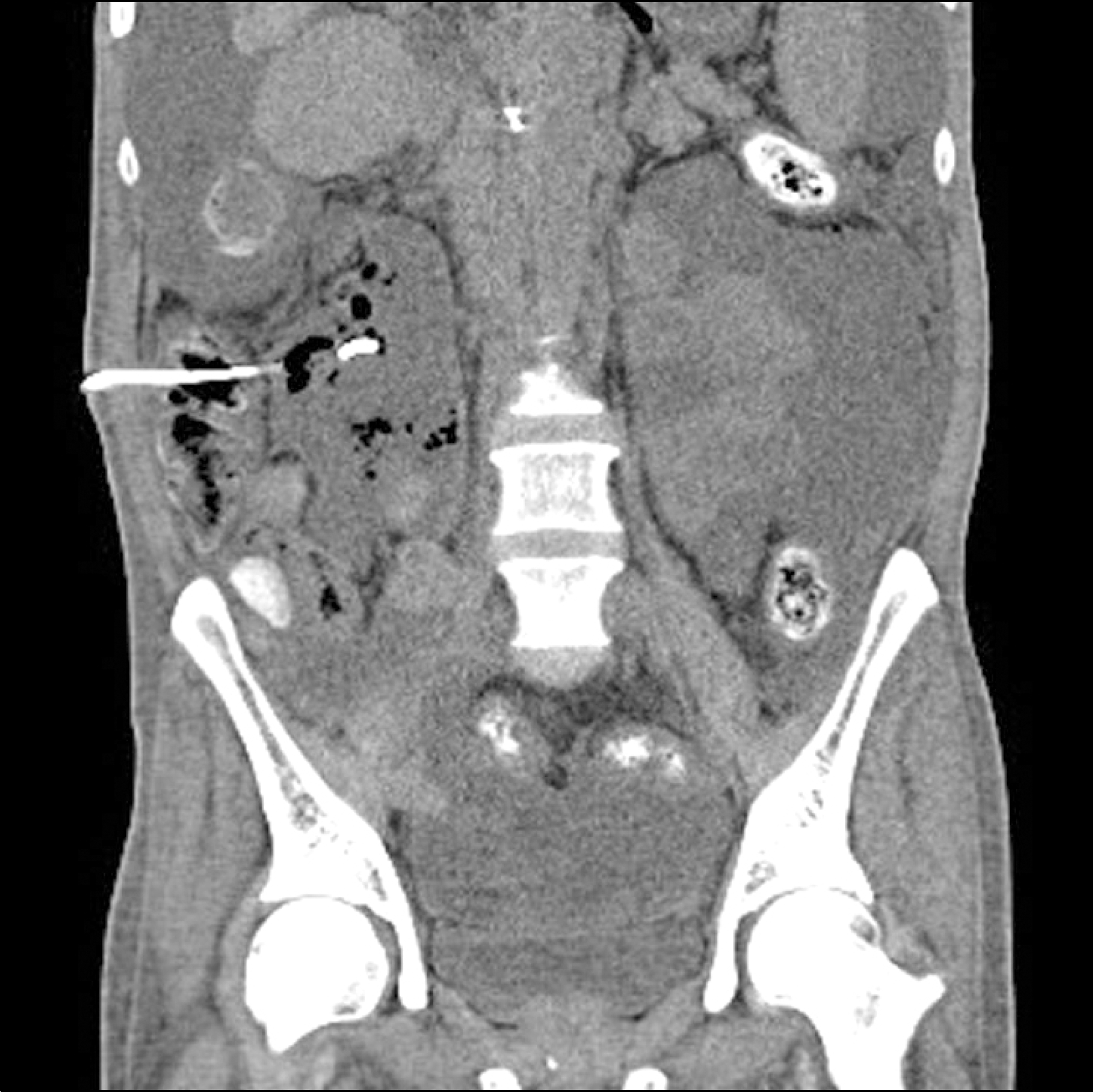Abstract
Advanced cancer patients with refractory ascites often do not respond to conventional treatments including dietary sodium restriction, diuretics, and repeated large volume paracentesis. In these patients, continuous peritoneal drainage by an indwelling catheter may be an effective option for managing refractory ascites with a relative low complication rate. Peritoneal catheter-in-duced complications include hypotension, hematoma, leakage, cellulitis, peritonitis, and bowel perforation. Although bowel perforation is a very rare complication, it can become disastrous and necessitates emergency surgical treatment. Herein, we report a case of a 57-year-old male with refractory ascites due to advanced liver cancer who experienced iatrogenic colonic perforation after peritoneal drainage catheter insertion and was treated successfully with endoscopic clipping.
Go to : 
References
1. Lungren MP, Kim CY, Stewart JK, Smith TP, Miller MJ. Tunneled peritoneal drainage catheter placement for refractory ascites: single-center experience in 188 patients. J Vasc Interv Radiol. 2013; 24:1303–1308.

2. Mercadante S, Intravaia G, Ferrera P, Villari P, David F. Peritoneal catheter for continuous drainage of ascites in advanced cancer patients. Support Care Cancer. 2008; 16:975–978.

3. Fleming ND, Alvarez-Secord A, Von Gruenigen V, Miller MJ, Abernethy AP. Indwelling catheters for the management of refractory malignant ascites: a systematic literature overview and retrospective chart review. J Pain Symptom Manage. 2009; 38:341–349.

4. Saif MW, Siddiqui IA, Sohail MA. Management of ascites due to gastrointestinal malignancy. Ann Saudi Med. 2009; 29:369–377.

5. Richard HM 3rd, Coldwell DM, Boyd-Kranis RL, Murthy R, Van Echo DA. Pleurx tunneled catheter in the management of malignant ascites. J Vasc Interv Radiol. 2001; 12:373–375.

6. Tapping CR, Ling L, Razack A. PleurX drain use in the management of malignant ascites: safety, complications, long-term patency and factors predictive of success. Br J Radiol. 2012; 85:623–628.

7. Song JH, Shim KN, Kim SE, et al. A case of successful endoscopic clipping in iatrogenic rectal perforation during colonoscopy. Intest Res. 2005; 3:154–155.
8. Kim JH, Jeon EJ, Song JH, et al. Colonoscopic perforation during a diagnostic colonoscopy. Korean J Gastrointest Endosc. 2011; 42:289–292.
9. Kim SA, Kim JH, Lee JH, Yang CH. A case of successful clipping of a colonic perforation during diagnostic colonoscopy. Korean J Gastrointest Endosc. 2009; 38:348–351.
10. Lee HN, Kim EJ, Park SK. A case of a successful band ligation of a colonic perforation during diagnostic colonoscopy. Korean J Gastrointest Endosc. 2010; 41:176–179.
11. Suh JH, Kim CS, Lee KC, Ko JC. Colonoscopic perforations: 4 years' experience. Korean J Gastrointest Endosc. 2009; 38:9–13.
12. Cho SB, Lee WS, Joo YE, et al. Therapeutic options for iatrogenic colon perforation: feasibility of endoscopic clip closure and predictors of the need for early surgery. Surg Endosc. 2012; 26:473–479.

13. Kim JS, Kim BW, Kim JI, et al. Endoscopic clip closure versus surgery for the treatment of iatrogenic colon perforations developed during diagnostic colonoscopy: a review of 115,285 patients. Surg Endosc. 2013; 27:501–504.

14. Rodriguez Lopez M, Blanco JI, Martinez R, et al. Clipping for endoscopic perforations: initial success but late complication requiring surgery. Surg Endosc. 2013; 27:3948–3950.

15. Park YS, Jang BI, Kim TN, et al. A case of colonic perforation following colonoscopy in collagenous colitis. Intest Res. 2007; 5:77–80.
16. Im JP, Jeon YK, Kim SG, et al. A case of cytomegalovirus colitis complicated by perforation after short-term steroid therapy in a patient with eosinophilia. Intest Res. 2007; 5:81–86.
17. Jung KW, Won YJ, Kong HJ, Oh CM, Seo HG, Lee JS. Cancer statistics in Korea: incidence, mortality, survival and prevalence in 2010. Cancer Res Treat. 2013; 45:1–14.

18. Lee HJ, Lee TH, Kim SM, et al. A case of iatrogenic colonic perforation repaired by endoscopic clipping. Korean J Gastrointest Endosc. 2005; 30:168–172.
19. Shin HP, Dong SH, Kim JH, Han YS. A case of iatrogenic rectal perforation repaired by endoscopic clipping. Korean J Gastrointest Endosc. 2003; 26:232–235.
Go to : 
 | Fig. 1.Abdominal CT scans shows ascites drainage catheter penetrating the mid-ascending colon. |
 | Fig. 2.Colonoscopic findings. (A) Penetrated 8.5 Fr catheter is noted at mid-ascending colon. (B) Hemoclipping was done at the penetrating site. (C) Catheter was then withdrawn and the openings were closed by applying 6 hemoclips. |
 | Fig. 3.Colonoscopy and fluoroscopy findings. (A) Dye leakage is not observed on the fluoroscopic image obtained on 12th hospital day. (B) Dye leakage is still absent on the fluoroscopic image obtained on 30th hospital day. (C) Colonoscopic view also demonstrates healed perforation without evidence of leakage. |




 PDF
PDF ePub
ePub Citation
Citation Print
Print


 XML Download
XML Download